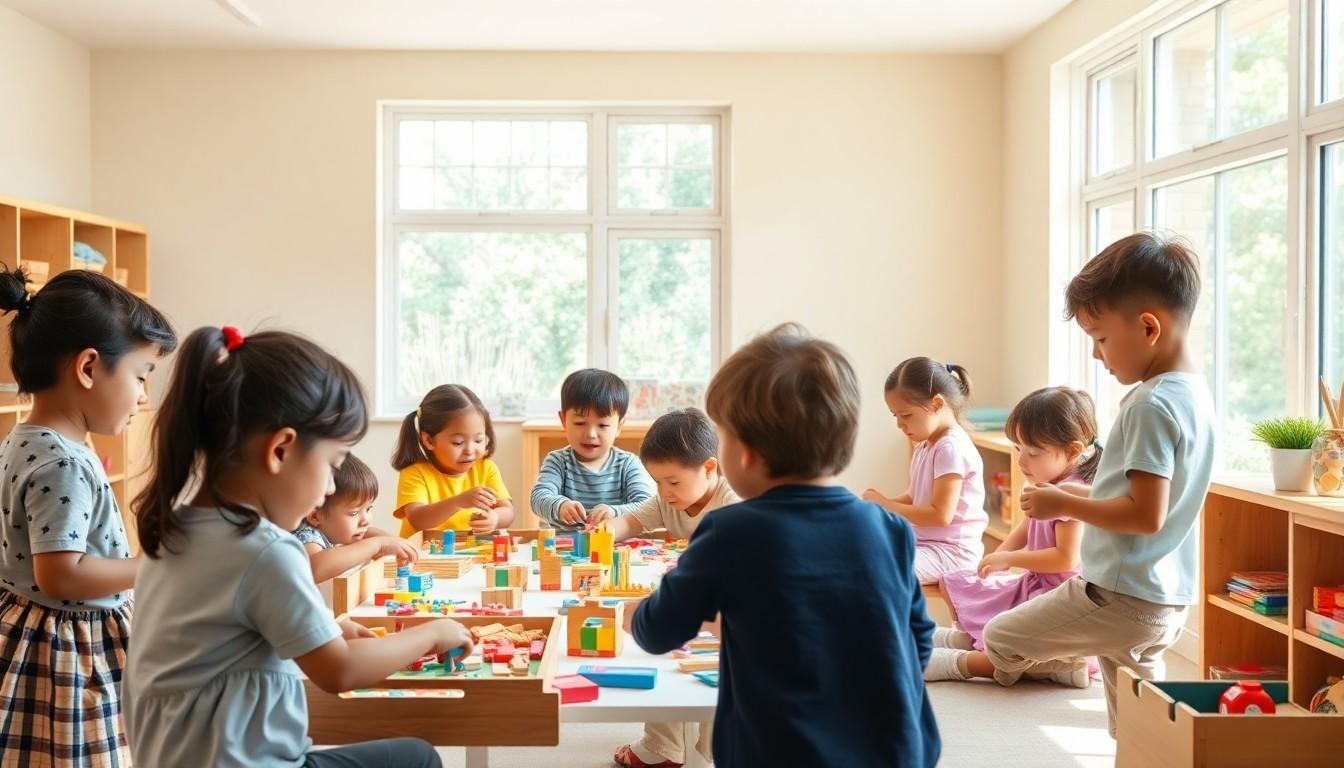Table of Contents
ToggleWhen it comes to education, one size definitely doesn’t fit all. Traditional schools can sometimes feel like a one-way street with no detours in sight. Luckily, alternative schooling options are popping up like wildflowers, offering fresh paths for curious minds. From Montessori magic to unschooling adventures, these alternatives cater to diverse learning styles and needs.
Overview of Alternative Schooling Options
Alternative schooling options cater to diverse learning needs, offering flexibility outside traditional educational frameworks. Montessori education focuses on self-directed activity, mixed-age classrooms, and hands-on learning experiences. This method emphasizes respect for a child’s natural psychological development, promoting exploration and independence.
Unschooling, another popular approach, centers on child-led learning. In this model, students pursue their interests, engaging in real-world experiences rather than following a structured curriculum. This option cultivates critical thinking and problem-solving skills, allowing learners to develop at their own pace.
Waldorf education integrates arts and academics, fostering creativity and imagination. It prioritizes experiential learning, with an emphasis on storytelling, music, and crafts. Each grade builds upon the previous one, ensuring a holistic development approach.
Online and hybrid schools have gained traction, particularly in recent years. These platforms provide a blend of virtual and in-person experiences, enabling students to tailor their education to fit their lifestyles. Cyber schools offer a range of courses, allowing learners to progress through content at their convenience.
Charter schools often operate independently from traditional district regulations, offering unique educational philosophies and teaching methodologies. Many focus on specific themes, such as STEM or the arts, providing specialized programs not often available in public schools.
Each of these alternative options presents distinct advantages, catering to various learning styles and preferences. They challenge conventional norms and empower students to take charge of their educational journeys.
Types of Alternative Schooling
Alternative schooling options encompass various educational methods that cater to individual learning preferences. Several approaches stand out, each offering unique benefits.
Montessori Method
Montessori education promotes self-directed learning. In this environment, children choose their activities, fostering independence. Classrooms feature mixed-age groups, enhancing peer learning. Teachers act as guides rather than instructors, emphasizing hands-on experiences. Flexibility in lesson plans allows students to explore subjects at their own pace. Research indicates that Montessori students often excel academically and socially compared to traditional school counterparts. This approach cultivates critical thinking and problem-solving skills.
Waldorf Education
Waldorf education integrates arts and academics. It prioritizes creativity and imagination, engaging students in various artistic activities, including music and painting. Structured yet adaptable, the curriculum follows developmental stages tailored to each child’s needs. Teachers foster strong relationships with students over multiple years, creating a stable learning environment. A focus on nature and outdoor learning nurtures a deep connection to the world. Studies suggest that Waldorf graduates exhibit strong social skills and resilience, preparing them for future challenges.
Homeschooling
Homeschooling provides personalized education options. Parents design a curriculum that aligns with their child’s interests and learning style. This flexibility allows for an in-depth exploration of topics that traditional settings might not cover. Many homeschooling families incorporate field trips and real-world experiences, enriching the educational journey. Regulatory requirements vary by state, giving families options within legal frameworks. Research demonstrates that homeschooled students often perform well on standardized tests and display high levels of engagement in their studies.
Benefits of Alternative Schooling Options
Alternative schooling options offer multiple advantages that cater to the unique needs of students. They promote an environment where learners thrive and reach their full potential.
Personalized Learning
Personalized learning is a hallmark of alternative education. Students often engage with customized curricula tailored to their interests and strengths. These educational approaches frequently allow for flexible pacing, letting learners progress when ready. Parent involvement enhances this experience by aligning educational content with family values. The emphasis on individuality fosters deeper connections to material, which often results in improved academic outcomes. Moreover, educators in alternative settings understand and adapt to different learning styles, creating a supportive atmosphere.
Enhanced Creativity
Enhanced creativity flourishes in alternative schooling environments. These options often incorporate art, music, and hands-on projects into the curriculum. Students express themselves freely, encouraging innovative thinking and exploration. Real-world experiences invite learners to connect classroom knowledge with their surroundings. The focus on collaborative activities further nurtures creativity, allowing students to brainstorm and troubleshoot together. By prioritizing creative expression, alternative schools produce well-rounded individuals capable of thinking outside the box.
Challenges of Alternative Schooling Options
Alternative schooling options face several challenges that can impact students and families.
Socialization Issues
Socialization remains a prominent concern in alternative education. Students enrolled in alternative programs often interact less frequently with peers, leading to isolation. Limited exposure to diverse social dynamics can hinder the development of essential social skills. In contrast, traditional schools provide regular interaction with various age groups, promoting social growth. Families sometimes express concern about adequate opportunities for social engagement in homeschooling or unstructured environments. Moreover, extracurricular activities offered by alternative schools may not match those available in conventional settings, impacting community involvement.
Resource Availability
Resource availability presents another challenge for alternative schooling options. Many programs lack funding compared to traditional public schools, restricting access to essential materials and facilities. Limited budgets can impact the hiring of qualified educators and the availability of specialized programs. Families may also find it difficult to access resources like textbooks, technology, or extracurricular activities, which play a vital role in a well-rounded education. Online and hybrid schools sometimes struggle with creating effective learning environments due to inadequate technological infrastructure. As a result, these disparities in resources can create obstacles for students in alternative education settings.
Selecting the Right Alternative Schooling Option
Choosing the right alternative schooling option requires careful consideration of several factors. Researching various educational philosophies helps determine which aligns with a child’s learning style. Families often assess the curriculum and teaching methods employed by the school to ensure they meet educational goals.
Evaluating the location is important as well. Proximity can affect daily logistics, particularly for younger students. Observing classroom environments during open houses allows families to gauge student engagement and teacher-student interactions.
Exploring the social opportunities offered by alternative schools is essential. Some options may provide extensive extracurricular activities that facilitate peer connections. Research indicates that certain programs emphasize community building, which can enhance a child’s social skills.
Understanding the financial implications of each option is crucial. Tuition requirements vary among private and charter schools, which might affect accessibility for some families. Availability of scholarships or financial aid programs can also influence decisions.
Considering parental involvement plays a significant role in the process. Many alternative education options encourage active participation from parents, fostering collaboration between home and school. This partnership can enhance the overall educational experience for the child.
Gathering feedback from current students and parents can provide valuable insights. Discussions with families already enrolled can highlight strengths and weaknesses of specific programs. Engaging in these conversations supports informed decision-making.
Lastly, trusting instincts matters. Each child is unique, and finding an educational approach that resonates with their personality and interests will lead to a more fulfilling experience. Prioritizing the child’s needs above all other factors leads to a well-informed choice.
Conclusion
Exploring alternative schooling options opens up a world of possibilities for students and families seeking tailored educational experiences. These diverse pathways empower learners to thrive in environments that suit their unique styles and interests. While challenges like socialization and resource availability exist, the benefits of personalized learning and creativity often outweigh these concerns.
As families consider their options, it’s crucial to align educational philosophies with a child’s needs. Engaging in thorough research and open communication can lead to informed decisions that enhance a child’s educational journey. Ultimately, embracing alternative education can foster a lifelong love of learning and equip students with the skills necessary for success in an ever-changing world.





